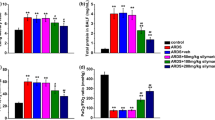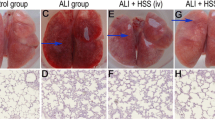Abstract
The aim of this study was to investigate the protective effects of N-acetylcysteine (NAC) on peroxidative and apoptotic changes in the contused lungs of rats following blunt chest trauma. The rats were randomly divided into three groups: control, contusion, and contusion + NAC. All the rats, apart from those in the control group, performed moderate lung contusion. A daily intramuscular NAC injection (150 mg/kg) was given immediately following the blunt chest trauma and was continued for two additional days following cessation of the trauma. Samples of lung tissue were taken in order to evaluate the tissue malondialdehyde (MDA) level, histopathology, and epithelial cell apoptosis using terminal deoxynucleotidyl transferase dUTP nick-end labeling (TUNEL) assay and active caspase-3 immunostaining. In addition, we immunohistochemically evaluated the expression of surfactant protein D (SP-D) in the lung tissue. The blunt chest trauma-induced lung contusion resulted in severe histopathological injury, as well as an increase in the MDA level and in the number of cells identified on TUNEL assay together with active caspase-3 positive epithelial cells, but a decrease in the number of SP-D positive alveolar type 2 (AT-2) cells. NAC treatment effectively attenuated histopathologic, peroxidative, and apoptotic changes, as well as reducing alterations in SP-D expression in the lung tissue. These findings indicate that the beneficial effects of NAC administrated following blunt chest trauma is related to the regulation of oxidative stress and apoptosis.



Similar content being viewed by others
References
Akca T, Canbaz H, Tataroglu C, Caglikulekci M, Tamer L, Colak T, Kanik A, Bilgin O, Aydin S (2005) The effect of N-acetylcysteine on pulmonary lipid peroxidation and tissue damage. J Surg Res 129:38–45
Aruoma OI, Halliwell B, Hoey BM, Butler J (1989) The antioxidant action of N-acetylcysteine: its reaction with hydrogen peroxide, hydroxyl radical, superoxide, and hypochlorous acid. Free Radic Biol Med 6:593–597
Cai S, Chen P, Zhang C, Chen JB, Wu J (2009) Oral N-acetylcysteine attenuates pulmonary emphysema and alveolar septal cell apoptosis in smoking-induced COPD in rats. Respirology 14:354–359
Cheng IW, Ware LB, Greene KE, Nuckton TJ, Eisner MD, Matthay MA (2003) Prognostic value of surfactant proteins A and D in patients with acute lung injury. Crit Care Med 31:20–27
Chiang CH, Chuang CH, Liu SL, Chian CF, Zhang H, Ryu JH (2012) N-acetylcysteine attenuates ventilator-induced lung injury in an isolated and perfused rat lung model. Injury 43:1257–1263
Cohn SM (1997) Pulmonary contusion: review of the clinical entity. J Trauma 42:973–979
De Flora S, Izzotti A, D’Agostini F, Balansky RM (2001) Mechanisms of N acetylcysteine in the prevention of DNA damage and cancer, with special reference to smoking-related end-points. Carcinogenesis 22:999–1013
De Paepe ME, Mao Q, Chao Y, Powell JL, Rubin LP, Sharma S (2005) Hyperoxia induced apoptosis and Fas/FasL expression in lung epithelial cells. Am J Physiol Lung Cell Mol Physiol 289:L647–L659
Dillioglugil MO, Ilgazli A, Maral H, Sengul C, Ozdemir G, Ercin C (2005) Protective effects of N-acetylcysteine on the peroxidative changes of rat lungs exposed to inhalation of thinners. Respirology 10:615–619
Draper HH, Hadley M (1990) Malondialdehyde determination as index of lipid peroxidation. Meth Enzymol 186:421–431
Fu YQ, Fang F, Lu ZY, Kuang FW, Xu F (2010) N-acetylcysteine protects alveolar epithelial cells from hydrogen peroxide-induced apoptosis through scavenging reactive oxygen species and suppressing c-Jun N-terminal kinase. Exp Lung Res 36:352–361
Gokce M, Saydam O, Hanci V, Can M, Bahadir B (2012) Antioxidant vitamins C, E and coenzyme Q10 vs Dexamethasone: comparisons of their effects in pulmonary contusion model. J Cardiothorac Surg 26:92
Guven B, Gokce M, Saydam O, Can M, Bektas S, Yurtlu S (2013) Effect of ghrelin on inflammatory response in lung contusion. Kaohsiung J Med Sci 29:69–74
Han F, Luo Y, Li Y, Liu Z, Xu D, Jin F, Li Z (2012) Seawater induces apoptosis in alveolar epithelial cells via the Fas/FasL-mediated pathway. Respir Physiol Neurobiol 182:71–80
Herbein JF, Wright JR (2001) Enhanced clearance of surfactant protein D during LPS-induced acute inflammation in rat lung. Am J Physiol Lung Cell Mol Physiol 281:268–277
Klein Y, Cohn SM, Proctor KG (2002) Lung contusion: pathophysiology and management. Curr Opin Anaesthesiol 15:65–68
Lee JH, Jo YH, Kim K, Lee JH, Rim KP, Kwon WY, Suh GJ, Rhee JE (2013) Effect of N-acetylcysteine (NAC) on acute lung injury and acute kidney injury in hemorrhagic shock. Resuscitation 84:121–127
Liener UC, Knöferl MW, Sträter J, Barth TF, Pauser EM, Nüssler AK, Kinzl L, Brückner UB, Gebhard F (2003) Induction of apoptosis following blunt chest trauma. Shock 20:511–516
Machado-Aranda D, Wang Z, Yu B, Suresh MV, Notter RH, Raghavendran K (2013) Increased phospholipase A(2) and lyso-phosphatidylcholine levels are associated with surfactant dysfunction in lung contusion injury in mice. Surgery 153:25–35
Matthay MA, Wiener Kronish JP (1990) Intact epithelial barrier function is critical for the resolution of alveolar edema in humans. Am Rev Respir Dis 142:1250–1257
Matute-Bello G, Winn RK, Jonas M, Chi EY, Martin TR, Liles WC (2001) Fas (CD95) induces alveolar epithelial cell apoptosis in vivo: implications for acute pulmonary inflammation. Am J Pathol 158:153–161
Miller PR, Croce MA, Bee TK, Qaisi WG, Smith CP, Collins GL, Fabian TC (2001) ARDS after pulmonary contusion: accurate measurement of contusion volume identifies high-risk patients. J Trauma 51:223–228
Mizuta M, Nakajima H, Mizuta N, Kitamura Y, Nakajima Y, Hashimoto S, Matsuyama H, Shime N, Amaya F, Koh H, Ishizaka A, Magae J, Tanuma SI, Hashimoto S (2008) Fas ligand released by activated monocytes causes apoptosis of lung epithelial cells in human acute lung injury model in vitro. Biol Pharm Bull 31:386–390
Modelska K, Pittet JF, Folkesson HG, Courtney Broaddus V, Matthay MA (1999) Acid-induced lung injury. Protective effect of anti-interleukin-8 pretreatment on alveolar epithelial barrier function in rabbits. Am J Respir Crit Care Med 160:1450–1456
Ozdulger A, Cinel I, Koksel O, Cinel L, Avlan D, Unlu A, Okcu H, Dikmengil M, Oral U (2003) The protective effect of N-acetylcysteine on apoptotic lung injury in cecal ligation and puncture-induced sepsis model. Shock 19:366–372
Pittet JF, Mackersie RC, Martin TR, Matthay MA (1997) Biological markers of acute lung injury: prognostic and pathogenetic significance. Am J Respir Crit Care Med 155:1187–1205
Raghavendran K, Davidson BA, Helinski JD, Marschke CJ, Manderscheid P, Woytash JA, Notter RH, Knight PR (2005) A rat model for isolated bilateral lung contusion from blunt chest trauma. Anesth Analg 101:1482–1489
Raghavendran K, Davidson BA, Knight PR, Wang Z, Helinski J, Chess PR, Notter RH (2008) Surfactant dysfunction in lung contusion with and without superimposed gastric aspiration in a rat model. Shock 30:508–517
Seitz DH, Perl M, Mangold S, Neddermann A, Braumüller ST, Zhou S, Bachem MG, Huber-Lang MS, Knöferl MW (2008) Pulmonary contusion induces alveolar type 2 epithelial cell apoptosis: role of alveolar macrophages and neutrophils. Shock 30:537–544
Shorr RM, Crittenden M, Indeck M, Hartunian SL, Rodriguez A (1987) Blunt thoracic trauma. Analysis of 515 patients. Ann Surg 206:200–205
Sırmalı M, Solak O, Tezel C, Sırmalı R, Ginis Z, Atik D, Agackıran Y, Koylu H, Delibas N (2013) Comparative analysis of the protective effects of caffeic acid phenethyl ester (CAPE) on pulmonary contusion lung oxidative stress and serum copper and zinc levels in experimental rat model. Biol Trace Elem Res 151:50–58
Strater J, Walczak H, Krammer PH, Moller P (1996) Simultaneous in situ detection of mRNA and apoptotic cells by combined hybridization and TUNEL. J Histochem Cytochem 44:1497–1499
Strohmaier W, Trupka A, Pfeiler C, Thurnher M, Khakpour Z, Gippner-Steppert C, Jochum M, Redl H (2005) Bilateral lavage with diluted surfactant improves lung function after unilateral lung contusion in pigs. Crit Care Med 33:2286–2293
Thompson AB, Robbins RA, Romberger DJ (1985) Immunological functions of the pulmonary epithelium. Eur Respir J 8:127–149
Thorburn A (2004) Death receptor-induced cell killing. Cell Signal 16:139–144
Tsuji F, Miyake Y, Aono H, Kawashima Y, Mita S (1999) Effects of bucillamine and N-acetylcysteine on cytokine production and collagen-induced arthritis. Clin Exp Immunol 115:26–31
Türüt H, Ciralik H, Kilinc M, Ozbag D, Imrek SS (2009) Effects of early administration of dexametahasone, N-acetylcysteine and aprotinin on inflammatory and oxidant- antioxidant status after lung contusion in rats. Injury 40:521–527
Verhasselt V, Vanden Berghe W, Vanderheyde N (1999) N-acetylcysteine inhibits primary human T cell responses at the dendritic cell level: association with NF-kB inhibition. J Immunol 162:2569–2574
Wang HC, Shun CT, Hsu SM, Kuo SH, Luh KT, Yang PC (2002) Fas/Fas ligand pathway is involved in the resolution of type II pneumocyte hyperplasia after acute lung injury: evidence from a rat model. Crit Care Med 30:1528–1534
Ware LB, Matthay MA (2001) Alveolar fluid clearance is impaired in the majority of patients with acute lung injury and the acute respiratory distress syndrome. Am J Respir Crit Care Med 163:1376–1383
Wright JR (2004) Host defense functions of pulmonary surfactant. Biol Neonate 85:326–332
Wu XJ, Xia ZY, Wang LL, Luo T, Zhan LY, Meng QT, Song XM (2012) Effects of penehyclidine hydrochloride on pulmonary contusion from blunt chest trauma in rats. Injury 43:232–236
Wu X, Song X, Li N, Zhan L, Meng Q, Xia Z (2013) Protective effects of dexmedetomidine on blunt chest trauma-induced pulmonary contusion in rats. J Trauma Acute Care 74:524–530
Acknowledgments
This study is supported by Trakya University Research Center, Edirne, Turkey, financially (Project No: 2012- 90).
Author information
Authors and Affiliations
Corresponding author
Rights and permissions
About this article
Cite this article
Topcu-Tarladacalisir, Y., Tarladacalisir, T., Sapmaz-Metin, M. et al. N-acetylcysteine counteracts oxidative stress and protects alveolar epithelial cells from lung contusion-induced apoptosis in rats with blunt chest trauma. J Mol Hist 45, 463–471 (2014). https://doi.org/10.1007/s10735-014-9563-6
Received:
Accepted:
Published:
Issue Date:
DOI: https://doi.org/10.1007/s10735-014-9563-6




